

From the earliest times mankind has been fascinated by monsters — creatures of bizarre, grotesque, or frightful configuration. Monsters were variously regarded as supernatural beings, creations of a wise and all-powerful god, omens signifying divine displeasure, or the products of cross-breeding between different species of animals or between humans and animals. Some were of purely imaginary origin, while others arose from faulty observation or misrepresentation of real creatures.Purely animal types included the dragon (winged scaly reptile), griffin (lion’s body with head and wings of an eagle), and chimaera (lion’s head, goat’s body and dragon’s tail). Partially human monsters included the centaur (human head and torso, body and legs of a horse), satyr (human head with horns, human torso, goat’s legs), and sphinx (head and bust of woman, wings, body of lion). Sea monsters included marine counterparts of land animals, such as sea horses, sea serpents, and sea dragons, as well as distinctive aquatic creatures. As on land, there were partially human varieties, such as Nereids (mermaids) and Tritons (mermen) with human heads and torsos, and fish’s tails.Remote areas of the world were believed to be populated by monstrous human races or tribes. Some were characterized by relatively mild deformities such as extra digits or limbs, single or quadruple eyes, absence of the mouth or nose, or enormous protruding lower lips. Others were more grotesque, with dog’s heads, or bird-like elongated necks and beaks, or lacking heads and having facial features on the chest. Monsters were prominently featured in classical Greek mythology, and were recorded in some detail in the fifth century B.C. historical writings of Herodotus. Pliny the elder, in his first century A.D. treatise on natural history, indiscriminately mingled fantasy with science, describing imaginary beasts and monstrosities along with real animals. Monster legends were perpetuated and embellished by the sensationalized and fraudulent writings of Gaius Julius Solinus (third century A.D.) and Sir John Mandeville (fourteenth century A.D.). Monster lore was thus widely disseminated and given great credibility from ancient times through the middle ages and even during the Renaissance. In terms of popular appeal, these curious beliefs may be compared to contemporary fascination with U.F.O.’s and science fiction.
This is one of the more spectacular maps in the Ortelius atlas, with its vivid depiction of the rugged terrain of Iceland including fiords, mountain ranges, glaciers, and the erupting Hekla volcano. Its most engaging feature, however, is the collection of fantastic sea monsters inhabiting the surrounding waters. Some of them are based on faulty observation or inaccurate descriptions of real creatures such as whales. It is likely that the majority derived from medieval legends, mariners' tales, or outright artistic license. As testimony to their purported authenticity, each of the creatures is assigned an identifying letter keyed to a detailed description on the back of the map.
map/352.0001
Item 25
Abraham Ortelius
Flemish, 1527-1598
Islandia, 1585
Engraving, hand colored
In: Theatro d'el Orbe de la Tierra
Antwerp, 1602
Smith Collection
*Map pictured here is the same state, but uncolored and a part of the Osher Collection
This atlas is a miniature counterpart of the Ortelius volume. Because of its handy size, informative text, neatly engraved maps, and modest cost, it was a popular favorite. The two sea monsters seen here are identical to those labeled D and E on the Ortelius map [# 25], evidence of copying or a shared source.
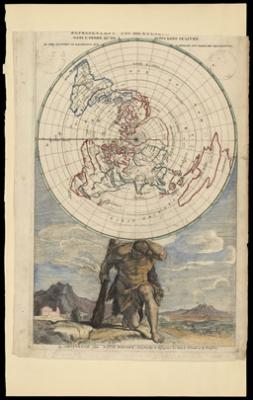
img/flat/unavailable.png
Item 26
Pieter van den Keere
Dutch, 1571-1646
[Islandt], 1598
In: Barent Langenes, Hand-boeck; ofCort begrijp der Caerten...
Amsterdam, 1609
Engraving
Smith Collection
Illustrations of this type, along with the known perils of frigid weather and icebergs, undoubtedly contributed to apprehension on the part of northern explorers. The accompanying text describes the creatures labeled "A" (upper left and lower right) as huge fish the size of mountains, called "Fish of the Devil." They were said to be capable of capsizing ships, but could be frightened away by the sound of trumpets or diverted by empty barrels with which they enjoyed playing. They were sometimes mistaken for islands, with disastrous results for sailors who landed on them. Monster "N" (right center) was described as a rhinoceros-like creature with a sharp pointed nose who was capable of devouring a crab twelve feet long. Monster "M" was a huge crab who crushed swimmers in its claws. On the other hand, "S" was a benevolent fish who protected swimmers.

map/260
Item 27
Sebastian Munster
German, 1489-1552
Les marins monstres & terrestres
From: Cosmographia
Basle, 1550
Woodcut
Osher Collection
This is the first separate map of the northwestern part of North America, depicting the region from present-day California to Alaska. The land animals are recognizable as goats and "cattle with humps like camels." The two sea creatures, however, are clearly monstrous. The "sea-unicorn" is particularly fanciful, and illustrates the notion that land animals, even imaginary ones, had marine equivalents.
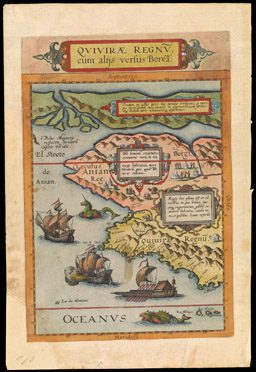
map/329
Item 28
Gerard de Jode
Dutch, 1509-1591
Quivirae Regnu cum alijs versus Borea
Amsterdam, 1593
Engraving, hand colored
Osher Collection
This rare and historic map documents the discoveries made by Willem Barents during his heroic expedition in search of a "Northeast Passage" over the top of Europe to the Orient. His ship was trapped in the ice and he survived the cruel Arctic winter, only to die of scurvy while en route home in the spring. His map, published posthumously, shows the tracks of his vessels and the newly discovered regions. In keeping with its scientific character, depictions of the sea creatures are more realistic, with recognizable walruses, seals, and whales predominating over sea monsters.
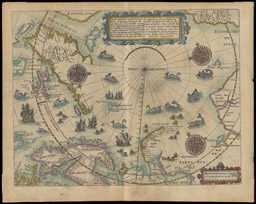
map/345
Item 29
Willem Barents
Dutch, 1550-1597
Delineatio cartae trium navigantium..., 1598
From: Jan Huygen van Linschoten, Itinerario...,
Antwerp, 1599
Engraving
Osher Collection
This is one of five known surviving copies of one of the earliest maps to show information from Sir Francis Drake's voyage around the world (1577-1580). The beautifully engraved "watered silk" oceans contain a variety of sea monsters, the largest and most distinctive of which appears to be quite docile and under the control of a female figure whose appearance may reflect Drake's encounter with South American Indians.
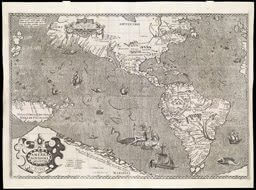
map/354
Item 30
Jodocus Hondius
Flemish, 1563-1612
Jean Le Clerc
French, 1560-1621
Americae Novissima Descriptio
London, 1589; Paris, 1602
Engraving
Osher Collection
This map is from Arias's eight-volume Polyglot Bible with text in Hebrew, Syriac, Greek and Latin. It records, with tables in Hebrew and Latin, the distribution of the descendants of Noah who repopulated the world after the great biblical flood. Location of some of them in the New World supports an early theory that the native Americans were descended from a lost tribe of Israel. Sea monsters abound, no doubt as examples of The Almighty's wondrous creations.
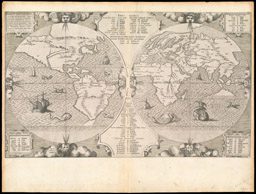
map/286
Item 31
Benito Arias Montano
Spanish, 1527-1598
Benedict. Arias Montanus Sacrae Geographiae Tabulam...l571
From: Biblia Sacra, Hebraice, Chaldaice, Graece & Latine...
Antwerp, 1572
Engraving
Osher Collection
On this map the seas are inhabited by traditional monsters under the supervision of Neptune and Amphi trite, with flying fish overhead. The "dark continent" of Africa, on the other hand, contains numerous vignettes of camels, elephants, ostriches, and other indigenous animals depicted realistically, except for their relative sizes. However, their strange and exotic appearance to unaccustomed European eyes elicited fascination and wonder not unlike a modern day visit to the circus.
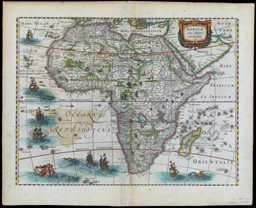
map/399
Item 32
Henricus Hondius
Dutch, 1597-1651
Africae nova Tabula
Amsterdam, 1631
Engraving, hand colored
Osher Collection
This map summarizes concepts of the world and its inhabitants prevalent in the late fifteenth century, before the news of the Columbian discoveries reached Europe. The geography is archaic, derived from the second-century work of Claudius Ptolemy. In the panel on the left and two additional panels on the back of the map there are images of bizarre humanoid monsters. These outlandish creatures were first described by the Greek physician Ctesias about 400 B.C., based on travellers' tales and his own visit to India. Later writers accepted these creatures as authentic semi-human beings who inhabited remote regions such as Ethiopia, India, and Scythia. Their fearsome appearance and purported bestial behavior constituted a potent deterrent to travel and exploration beyond the civilized world. On the other hand, some medieval church fathers pointed out that as descendants of Adam they had souls and were deserving of salvation.
The enlarged images on both sides are from the back of the map:

map/7324.0072c
Item 33
Hartmann Schedel
German, 1440-1514
Untitled Ptolemaic map of the world
In: Registrum hujus opens libri cronicarum...
Nuremberg, 1493
Woodcut
Osher Collection